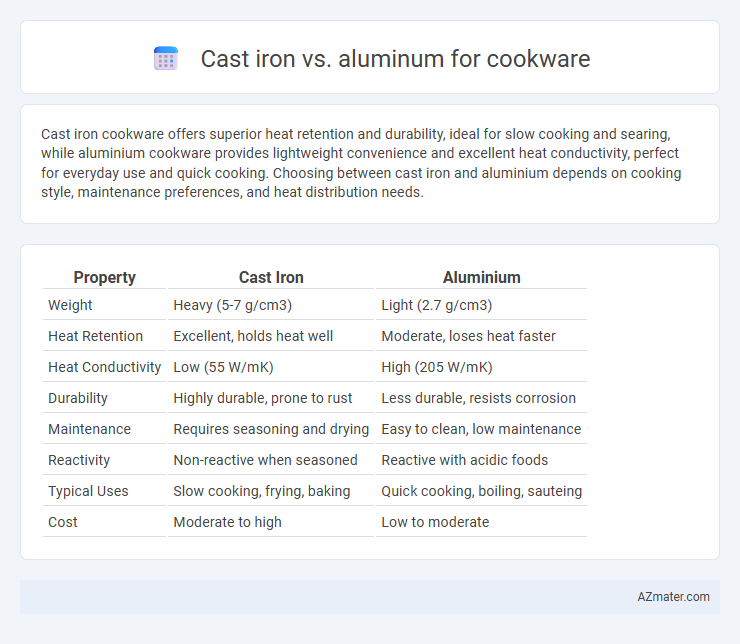Cast iron cookware offers superior heat retention and durability, ideal for slow cooking and searing, while aluminium cookware provides lightweight convenience and excellent heat conductivity, perfect for everyday use and quick cooking. Choosing between cast iron and aluminium depends on cooking style, maintenance preferences, and heat distribution needs.
Table of Comparison
| Property | Cast Iron | Aluminium |
|---|---|---|
| Weight | Heavy (5-7 g/cm3) | Light (2.7 g/cm3) |
| Heat Retention | Excellent, holds heat well | Moderate, loses heat faster |
| Heat Conductivity | Low (55 W/mK) | High (205 W/mK) |
| Durability | Highly durable, prone to rust | Less durable, resists corrosion |
| Maintenance | Requires seasoning and drying | Easy to clean, low maintenance |
| Reactivity | Non-reactive when seasoned | Reactive with acidic foods |
| Typical Uses | Slow cooking, frying, baking | Quick cooking, boiling, sauteing |
| Cost | Moderate to high | Low to moderate |
Introduction to Cast Iron and Aluminium Cookware
Cast iron cookware is known for its exceptional heat retention, even cooking, and durability, making it ideal for searing, frying, and slow-cooking. Aluminium cookware offers superior heat conductivity, lightweight handling, and rapid temperature adjustments, favored for everyday cooking and delicate dishes. Both materials require distinct care: cast iron benefits from seasoning to maintain its non-stick surface, while aluminium needs anodizing or non-stick coatings to enhance durability and prevent reactivity with acidic foods.
Material Composition and Manufacturing Process
Cast iron cookware is made from molten iron with 2-4% carbon content, providing excellent heat retention and durability through a process of sand casting or forging. Aluminium cookware is crafted from lightweight aluminum alloys, typically mixed with elements like magnesium or silicon, using methods such as extrusion or die-casting to enhance thermal conductivity and resistance. The dense, porous structure of cast iron demands seasoning to prevent rust, while aluminum's malleable composition allows for quicker, energy-efficient manufacturing and corrosion resistance.
Heat Retention and Distribution Performance
Cast iron excels in heat retention due to its dense structure, maintaining steady temperatures ideal for slow cooking and searing. Aluminium offers superior heat distribution with rapid and even warming, preventing hot spots during cooking. Choosing between cast iron and aluminium depends on whether sustained heat or quick, uniform cooking is prioritized.
Weight and Ease of Handling
Cast iron cookware is significantly heavier than aluminum, often weighing two to three times more, which can make handling cumbersome, especially for prolonged cooking tasks. Aluminum offers a lightweight alternative, enhancing ease of handling and providing quicker maneuverability when stirring or tossing food. The substantial weight of cast iron contributes to excellent heat retention but may challenge users with limited strength or dexterity.
Durability and Longevity
Cast iron cookware offers exceptional durability, often lasting several decades due to its dense, heavy composition that resists warping and scratching. Aluminium cookware, while lightweight and heat-conductive, is prone to denting and corrosion over time, which can reduce its longevity. Properly maintained cast iron can outlast aluminium by several times, making it a preferred choice for long-term kitchen use.
Maintenance and Cleaning Requirements
Cast iron cookware requires regular seasoning to maintain its non-stick surface and prevent rust, demanding thorough drying after each wash to avoid moisture damage. Aluminium cookware is easier to clean due to its smooth, non-porous surface but can be prone to discoloration and scratching if abrasive cleaners or metal utensils are used. Proper maintenance for cast iron ensures longevity and enhanced flavor, while aluminium benefits from gentle cleaning to retain appearance and performance.
Nonstick Capabilities and Cooking Surface
Cast iron cookware offers a naturally nonstick surface when properly seasoned, allowing for excellent heat retention and even cooking, ideal for searing and frying. Aluminium cookware typically features an anodized or nonstick coating, providing quick heat conduction and easy food release but may wear out faster compared to cast iron seasoning. While cast iron improves its nonstick properties over time, aluminium requires careful handling of the coating to maintain a smooth cooking surface and prevent flaking.
Compatibility with Heat Sources
Cast iron cookware demonstrates excellent compatibility with all heat sources, including induction cooktops, gas stoves, and electric burners, due to its magnetic properties and high heat retention. Aluminum cookware, while highly efficient with gas and electric stoves due to its rapid heat conduction, is generally incompatible with induction cooktops unless it has a magnetic base layer. Selecting cookware based on heat source compatibility ensures optimal cooking performance and energy efficiency in the kitchen.
Health and Safety Considerations
Cast iron cookware is praised for its durability and ability to release beneficial iron into food, which can support iron intake but may cause issues for individuals with hemochromatosis. Aluminum cookware is lightweight and offers excellent heat conductivity but may pose health concerns if uncoated due to aluminum leaching, especially when cooking acidic foods. Choosing coated or anodized aluminum reduces leaching risks, while cast iron demands seasoning to prevent rust and maintain a non-stick surface, ensuring safer cooking conditions.
Price Range and Value for Money
Cast iron cookware typically ranges from $20 to $100 depending on size and brand, offering exceptional durability and heat retention for long-term value. Aluminium cookware, priced between $15 and $80, provides lightweight convenience and faster heating but may lack the lifespan of cast iron. Value for money favors cast iron for those seeking longevity and even heat distribution, while aluminium suits budget-conscious buyers prioritizing ease of use and affordability.

Infographic: Cast iron vs Aluminium for Cookware
 azmater.com
azmater.com